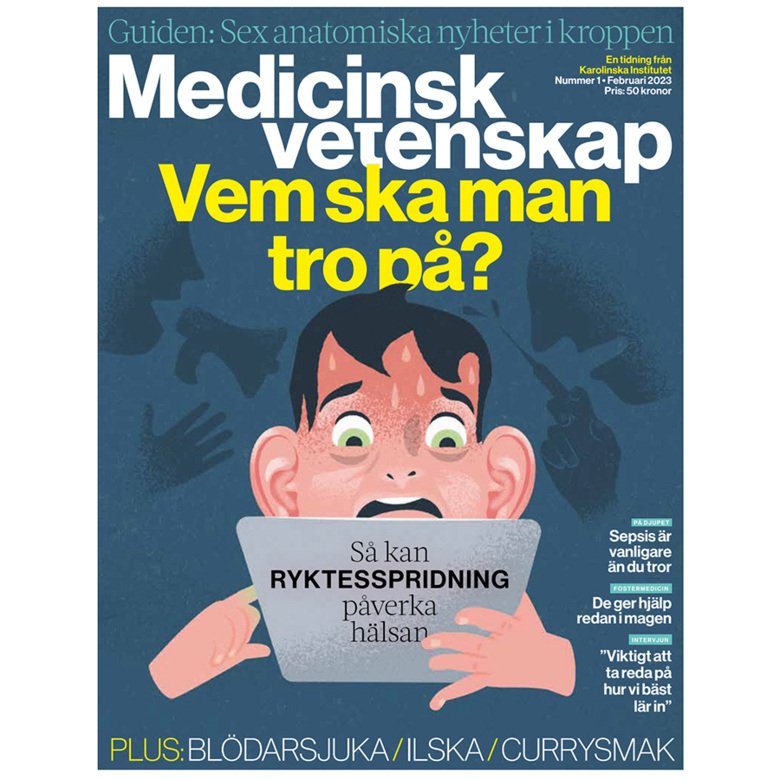Internet CBT may help to heal a broken heart

It is common for middle-aged women with suspected myocardial infarction to be diagnosed with broken heart syndrome instead, which is triggered by stress and grief. Per Tornvall hopes that his research will result in more people receiving the correct diagnosis and fewer people suffering a relapse. He is now testing to see if internet CBT may help to heal the heart.
Text: Felicia Lindberg, first published in the magazine Medicinsk Vetenskap nr 3, 2023.
Per Tornvall has done research on broken heart syndrome for roughly 20 years and can remember clearly what first awakened his interest. A woman in her 50s came into the myocardial infarction unit at Karolinska University Hospital, where he was working as a cardiologist at the time. She had classic symptoms of a myocardial infarction, but one could not detect any narrowing of the heart's coronary arteries, which is normally indicative of a myocardial infarction.
"She was a middle manager at a large company where constant organisational changes were causing her a great deal of stress, she felt pressure both from upper and lower management. I didn't know at the time what the cause was but suspect today that she was suffering from broken heart syndrome. Since then, I have devoted my research to trying to find risk genes and examining how the condition can be diagnosed and treated," says Per Tornvall, Professor at the Department of Clinical Science and Education, Södersjukhuset, at Karolinska Institutet and Senior Consultant at the cardiology clinic at Södersjukhuset.
Broken heart syndrome was first discovered in Japan in the 1990s and is also referred to as takotsubo after the Japanese word for octopus trap, which describes the appearance of the heart ventricle in patients who suffer from this. One of the ventricles, typically the left one, swells up and becomes like a limp bag, which makes it harder for the heart to pump. The consequence is typical symptoms of a myocardial infarction, with chest pains, breathlessness and sometimes fainting. Blood counts and ECG (electrocardiography) also indicate myocardial infarction, but since the heart's coronary arteries are healthy it is a separate condition that is rather similar to heart failure.
Broken heart syndrome has shown to be the cause of a few percent of all suspected myocardial infarctions, with a clear over-representation among women.
"In total, at least a thousand people per year in Sweden are affected by this and the typical patient is a woman in her upper middle age who has recently suffered severe stress or grief. I would like to call it a brain-heart disease," says Per Tornvall.
Research shows that there is a strong link to mental or physical stress. Studies have also shown changes in the part of the brain that controls the so-called autonomous nervous system, which controls our inner organs.
"During my years as a cardiologist, I have encountered many patients who tell me about dramatic events such as the sudden loss of a family member, traffic accidents and houses burning down with the pets still inside. You can often see that there is both prolonged stress and acute stress which may have been the last straw. One has also noted an increase in heart problems similar to takotsubo in connection with major disasters such as earthquakes and terrorist attacks.
Why this occurs to women to a larger extent has not been pinpointed, but some studies indicate that oestrogen plays a role. When oestrogen levels drop in connection with menopause, the number of stress receptors in the heart increases. In younger women and men, broken heart syndrome is also equally common, but after menopause it is around five times more common in women.

We don't know how the condition should be treated most effectively either, but often we use the same drugs as we do for heart failure," says Per Tornvall.
"The most common is for the heart to return to normal within a few days or weeks and most people make a full recovery, but unfortunately a few percent suffer a relapse. Some suffer from complications such as irregular heartbeats, serious heart failure and even death."
The prognosis is roughly comparable to that of a myocardial infarction.
"It's common for long sick leave to occur, so it is definitely not a trivial diagnosis. It is important to increase awareness among the public so that we become better equipped to take care of our mental health before the heart or other organs suffer. The classic advice about eating well, sleeping properly, exercising and not smoking apply," says Per Tornvall.
He also feels that healthcare needs to improve its prevention and treatment of stress-related conditions such as broken heart syndrome. One part of the solution may be internet-based CBT, cognitive behavioural therapy, which makes it more accessible to people in order to reduce their stress levels. In an ongoing study, patients with broken heart syndrome receive internet CBT, which Per Tornvall and his research colleagues have developed together with patients and psychologists.
Another research path is to improve diagnostics in patients with suspected myocardial infarction and normal coronary arteries. Not everyone has broken heart syndrome, but may instead be suffering from myocarditis, and some people never receive a definite diagnosis. An important part of the work has been a close collaboration between hospitals in the Stockholm region in order to implement an early magnetic resonance scan (MR) of the heart. Previous studies from the research group have shown that one can then detect the characteristic swell in the heart and provide a correct diagnosis.
"An ultrasound of the heart can sometimes detect takotsubo, but MR, which is a more expensive and somewhat more difficult method, is better.
In collaboration with researchers at KTH and the University of Cambridge, he is also running a project to improve the interpretation of an ECG with the help of artificial intelligence, AI. Patients with broken heart syndrome show complex ECG changes that may be difficult for a human being to interpret, but that appear to be unique for that condition. The AI model will be tested on patient-ECG during the autumn of 2023.
"My long-term goal is that we will find more people who suffer from broken heart syndrome and that they will then receive evidence-based treatment that reduces the risk of a relapse," says Per Tornvall.
Several different heart diagnoses
Up to ten percent of all patients and a third of all female patients with suspected myocardial infarction have healthy coronary arteries. They are then diagnosed with MINOCA (myocardial infarction with non-obstructive coronary arteries), which may later result in several different diagnoses, with broken heart syndrome being the most common. Other diagnoses include myocardial infarction depending on a blood clot or myocarditis. Broken heart syndrome, or takotsubo, was previously classified as a form of myocardial infarction but is now an independent diagnosis. However, it still lacks a diagnosis code.
Source: Per Tornvall
 Photo: Jens Magnusson
Photo: Jens MagnussonRead more articles about medical research
Read about the latest in medical science in Karolinska Institutet's Swedish language popular science magazine Medicinsk Vetenskap. Subscribe now!
